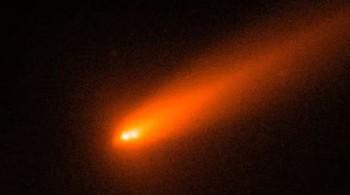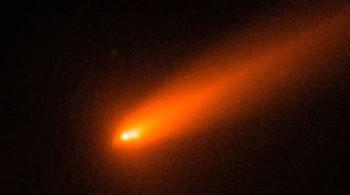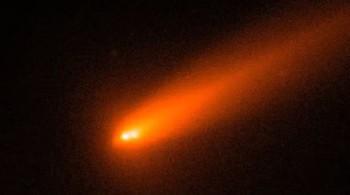
Comet C/2025 K1 (ATLAS) breaks into 3 after coming close to Sun
The fascinating world of astronomy has always been filled with surprises and wonders. Recently, a remarkable event has occurred in our solar system, leaving astronomers and space enthusiasts in awe. Comet C/2025 K1 (ATLAS), a comet that was discovered earlier this year, has broken into three pieces after swinging too close to the Sun. This extraordinary event was captured by astronomers using Italy’s Copernicus telescope, providing stunning images of the comet’s fragmentation.
The comet’s journey began like any other, with it traveling through the vast expanse of space, carrying with it the secrets of the early solar system. However, its trajectory took it perilously close to the Sun, and on October 8, it passed within a mere 1.6 astronomical units (AU) of the Sun’s center. One astronomical unit is the average distance between the Earth and the Sun, which is about 93 million miles or 149.6 million kilometers. This close encounter with the Sun had a profound effect on the comet, causing its nucleus to become unstable.
As the comet approached the Sun, the intense heat and radiation emanating from our star began to take its toll on the comet’s icy surface. The comet’s ices, which were once frozen and stable, began to vaporize and sublimate, creating a bright coma and tail. However, this process also weakened the comet’s structural integrity, making it more susceptible to fragmentation.
The fragmentation of Comet C/2025 K1 (ATLAS) was a spectacular event, with two large chunks of the comet breaking off and drifting apart. These two pieces, which are estimated to be around 2,000 kilometers apart, are the largest remnants of the original comet. A smaller, third piece can also be seen to the left of the pair, a testament to the violent forces that tore the comet asunder.
The images captured by the Copernicus telescope in Italy provide a stunning glimpse into this remarkable event. The telescope’s high-resolution cameras were able to resolve the individual fragments of the comet, allowing astronomers to study the comet’s breakup in unprecedented detail. The images show the two main fragments, each with its own coma and tail, as well as the smaller, third piece, which appears to be a much smaller and more irregularly shaped fragment.
This event is not only fascinating from a scientific perspective, but it also provides astronomers with a unique opportunity to study the internal structure and composition of comets. By analyzing the fragments of Comet C/2025 K1 (ATLAS), scientists can gain valuable insights into the formation and evolution of our solar system. Comets are thought to be remnants from the early days of the solar system, and their composition and structure can provide clues about the conditions that existed during the solar system’s formation.
The breakup of Comet C/2025 K1 (ATLAS) is also a reminder of the dynamic and unpredictable nature of our solar system. Comets, in particular, are known for their unpredictability, and their orbits can be affected by a variety of factors, including the gravitational influence of the Sun and other planets. This event serves as a reminder of the awe-inspiring complexity and beauty of our solar system, and the many mysteries that still remain to be uncovered.
In conclusion, the breakup of Comet C/2025 K1 (ATLAS) is a remarkable event that has captivated astronomers and space enthusiasts around the world. The stunning images captured by the Copernicus telescope provide a unique glimpse into the comet’s fragmentation, and offer valuable insights into the internal structure and composition of comets. As scientists continue to study this event, they may uncover new and exciting information about the formation and evolution of our solar system.






